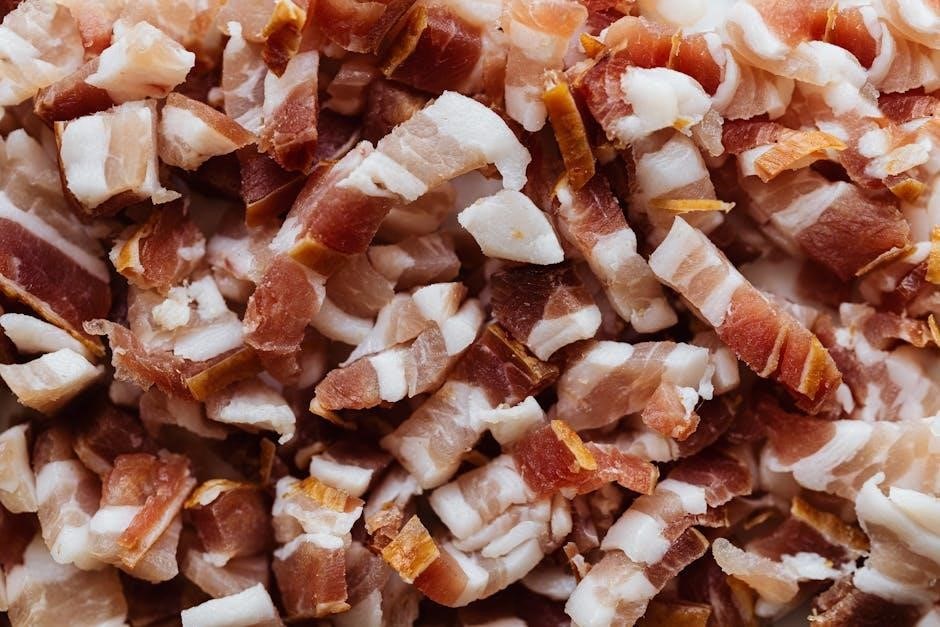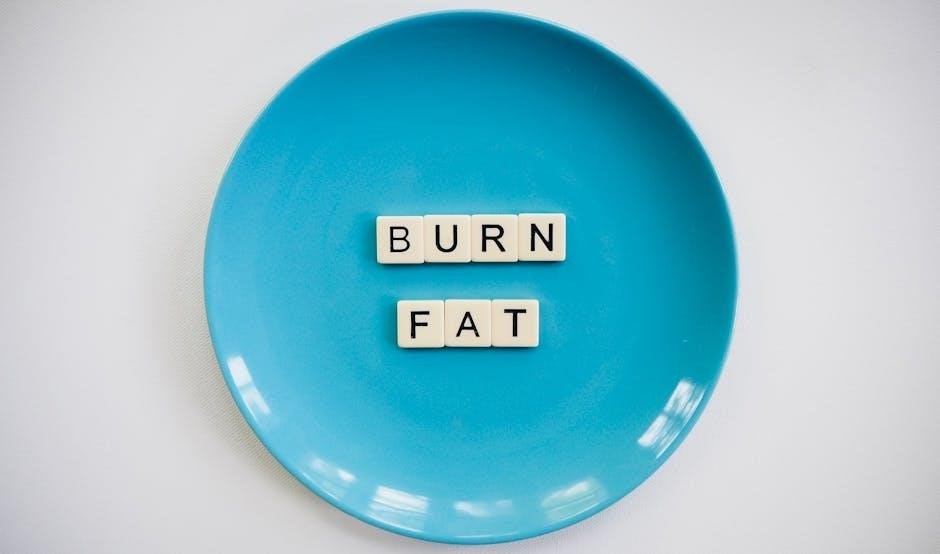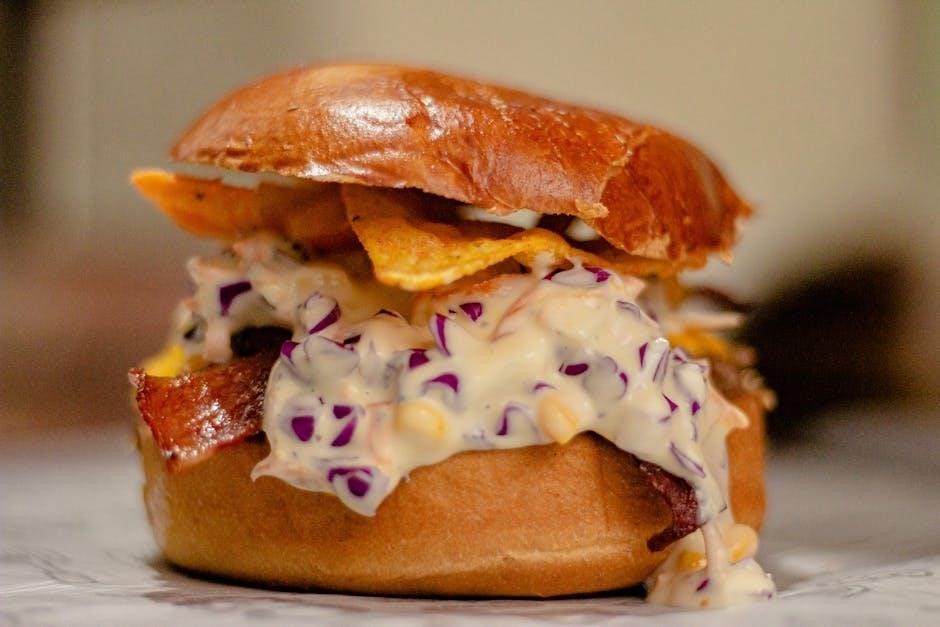Welcome to the Gains by Brains Fat Loss Guide PDF, your comprehensive resource for achieving effective and lasting fat loss․ This guide offers a structured approach blending scientific principles with practical strategies to help you succeed․
1․1 Overview of the Gains by Brains Fat Loss Guide PDF
The Gains by Brains Fat Loss Guide PDF is a comprehensive resource designed to help individuals achieve sustainable fat loss through evidence-based strategies․ It combines scientific insights with practical, actionable advice, making it accessible for both beginners and experienced individuals․ The guide focuses on nutrition, training, and mindset, providing a holistic approach to fat loss․ By emphasizing long-term sustainability over quick fixes, it equips readers with the tools to transform their bodies and maintain results․ This guide is perfect for those seeking a structured, no-nonsense plan to reach their fat loss goals effectively and healthily․
1․2 Importance of a Structured Fat Loss Plan
A structured fat loss plan is essential for achieving sustainable results․ Without a clear roadmap, efforts often become chaotic, leading to inconsistent progress and potential burnout․ A well-organized plan provides accountability, ensures efficiency, and helps maintain motivation․ It also minimizes the risk of costly mistakes, such as extreme calorie restriction or overtraining․ By following a structured approach, individuals can track progress, make informed adjustments, and stay committed to their goals․ A plan also fosters a sense of control, reducing stress and making the fat loss journey more manageable․ Ultimately, structure is the foundation for long-term success․
1․3 What to Expect from the Guide
In the Gains by Brains Fat Loss Guide PDF, you can expect a comprehensive and easy-to-follow roadmap to achieving your fat loss goals․ The guide is designed to educate and empower, providing clear strategies and actionable advice․ You’ll gain insights into scientific principles, nutrition, training, and mindset, all tailored to help you lose fat sustainably․ The guide is packed with practical tips, real-life examples, and expert recommendations to ensure you stay on track․ By the end, you’ll have the tools and confidence to transform your body and maintain your results long-term․ This guide is your ultimate blueprint for success․

Core Principles of the Gains by Brains Fat Loss Guide
This guide is built on proven scientific principles, emphasizing balance, sustainability, and precision․ It integrates nutrition, training, and mindset to create a holistic approach to fat loss․
2․1 The Science of Fat Loss
Fat loss is rooted in biology and physiology, governed by the body’s energy balance system․ It begins with a caloric deficit, where the body burns more calories than it consumes․ This deficit triggers the release of stored energy, primarily from fat cells, through a process called lipolysis․ Hormones like insulin and glucagon play crucial roles in regulating this process․ Understanding these mechanisms helps optimize fat loss efforts․ The guide explains how to leverage this science to create a sustainable and effective fat loss strategy, ensuring long-term success without harming overall health․ Science forms the foundation of every recommendation․
2․2 Nutrition as the Foundation
Nutrition is the cornerstone of any successful fat loss journey․ It dictates how your body utilizes energy and stores fat․ The guide emphasizes the importance of a balanced diet tailored to your goals, focusing on whole, nutrient-dense foods․ Understanding how calories, macronutrients, and micro-nutrients work together is crucial․ By prioritizing protein to preserve muscle, carbohydrates for energy, and healthy fats for hormonal balance, you create an optimal environment for fat loss․ The guide also highlights the role of meal planning and hydration in maintaining consistency and maximizing results․ A well-structured nutrition plan is essential for sustainable progress․
2․3 The Role of Training in Fat Loss
Training plays a crucial role in fat loss by enhancing metabolism and building muscle․ The guide advocates for a combination of resistance training and cardiovascular exercise to maximize results․ Resistance training helps preserve and build muscle mass, which boosts resting metabolic rate, while cardio accelerates calorie burn during workouts․ Incorporating High-Intensity Interval Training (HIIT) is also recommended for its efficiency in fat loss․ The guide emphasizes the importance of progressive overload and consistency to keep challenging the body and avoid plateaus․ A well-balanced training routine not only promotes fat loss but also improves overall physical health and fitness․
2․4 Mindset and Consistency
A positive mindset is essential for successful fat loss․ The guide emphasizes the importance of mental resilience and self-discipline to stay on track․ Consistency is key, as fat loss requires long-term commitment rather than sporadic efforts․ By fostering a growth mindset, individuals can overcome obstacles and adapt to challenges․ The guide provides strategies to build mental toughness and maintain motivation, ensuring sustainable progress․ Without consistency, even the best plans fail, making mindset the cornerstone of any successful fat loss journey․ The guide teaches how to cultivate habits that promote long-term adherence and discipline, leading to lasting results․

Why Most People Fail at Fat Loss
Many individuals struggle with fat loss due to lack of knowledge, unrealistic expectations, and poor execution of their strategies․ This section reveals the common pitfalls hindering success․
3․1 Common Mistakes in Fat Loss Diets
One of the most prevalent errors in fat loss diets is extreme caloric restriction, which can lead to muscle loss and metabolic slowdown․ Many individuals also neglect protein intake, failing to preserve muscle mass․ Additionally, over-reliance on processed foods and inadequate micronutrient intake can hinder progress․ Another mistake is ignoring meal timing and portion control, leading to inconsistent results․ Lastly, lack of accountability and unrealistic expectations often cause frustration and abandonment of the diet․ Addressing these common pitfalls is crucial for achieving sustainable fat loss․
Fad diets and quick fixes often promise rapid results but lack sustainability and can be harmful to overall health․ These diets frequently restrict entire food groups, leading to nutrient deficiencies and imbalanced nutrition․ They also ignore long-term lifestyle changes, causing individuals to regain weight once they revert to old habits․ Additionally, extreme restrictions can result in metabolic slowdown and decreased muscle mass․ The Gains by Brains Fat Loss Guide emphasizes sustainable practices, discouraging reliance on fad diets and promoting a balanced, maintainable approach to fat loss․ This ensures healthier, more permanent results․ Many people believe that endless hours of cardio or targeted exercises are the keys to fat loss․ However, this is a common misconception․ While exercise plays a role, it is not the sole determinant of fat loss․ Spot reduction (losing fat from specific areas) is also a myth, as fat loss occurs systemically․ Additionally, overtraining can lead to burnout and decreased adherence․ The Gains by Brains Fat Loss Guide highlights the importance of a balanced approach, combining strength training, cardio, and proper nutrition to achieve sustainable results․ Consistency and patience are far more effective than chasing quick fixes or outdated workout trends․ Nutrition is the cornerstone of fat loss․ This section explores how to create a caloric deficit, balance macronutrients, and develop sustainable eating habits for lasting results․ A caloric deficit is the foundation of fat loss, occurring when you consume fewer calories than your body burns․ To achieve this, it’s essential to understand your total daily energy expenditure (TDEE), which includes your resting metabolic rate, physical activity, and other bodily functions․ Subtracting 500 calories from your maintenance calories typically results in about a pound of fat loss per week․ However, extreme calorie restriction can lead to muscle loss and fatigue․ A moderate deficit of 20-25% below maintenance is often more sustainable․ Pairing this with a high-protein diet helps preserve muscle mass․ Consistency is key․ A well-structured macronutrient breakdown is crucial for effective fat loss․ Protein should be prioritized, making up 25-30% of daily calories, to preserve muscle mass․ Carbohydrates, accounting for 40-50%, provide energy and support training performance․ Fats, at 25-30%, are essential for hormone health․ Balancing these ensures sustained energy and satisfaction, reducing the likelihood of diet sabotage․ Adjustments can be made based on individual needs and progress, but maintaining this ratio supports both fat loss and overall health․ Consistency and tracking are vital for long-term success․ Protein is essential for preserving muscle mass during fat loss․ It provides the building blocks for muscle repair and maintenance, preventing muscle breakdown․ Aim for 1․6-2․2 grams of protein per kilogram of body weight daily․ Distribute protein intake evenly across meals to maintain muscle synthesis․ Leucine, a key amino acid, plays a critical role in muscle preservation․ Prioritize whole food sources like lean meats, fish, eggs, and legumes, and consider supplements for convenience․ Without adequate protein, muscle loss can occur, slowing metabolism and hindering progress․ Consistency in protein intake is vital for maintaining muscle while losing fat․ Carbohydrates play a significant role in fat loss by providing energy and regulating metabolism․ They are essential for high-intensity workouts and support muscle preservation․ Focus on complex carbs like whole grains, fruits, and vegetables, which offer sustained energy and fiber․ Timing carbs around workouts can optimize performance and recovery․ While low-carb diets may lead to initial weight loss, they can be challenging to maintain long-term․ Balancing carb intake with overall calorie needs ensures sustainable fat loss without sacrificing energy levels or muscle mass․ Pairing carbs with protein enhances nutrient absorption and supports a balanced diet․ Healthy fats are essential for overall health and fat loss․ They support hormone production, brain function, and the absorption of fat-soluble vitamins․ Incorporate sources like avocados, nuts, seeds, and olive oil into your diet․ While fats are calorie-dense, they provide sustained energy and reduce hunger, making them beneficial for adherence to a calorie-deficient diet․ However, portion control is key to avoid overconsumption․ Balancing healthy fats with other macronutrients ensures a well-rounded approach to fat loss, supporting both physical and mental well-being․ Prioritize quality over quantity to maximize their benefits in your fat loss journey․ Meal frequency and timing can significantly impact your fat loss journey․ Eating smaller, balanced meals throughout the day may help maintain metabolism and control hunger․ However, research shows that total calorie intake, not meal frequency, primarily drives fat loss․ Some find success with intermittent fasting, while others prefer more frequent meals․ The key is to choose a schedule that fits your lifestyle and ensures consistency․ Timing meals around workouts can optimize performance and recovery, but overall, focus on meeting your caloric and macronutrient needs rather than rigid timing․ Flexibility is crucial for sustainable fat loss․ Effective training is essential for fat loss, combining resistance, cardio, and HIIT to maximize results․ A well-structured routine boosts metabolism, preserves muscle, and enhances overall fitness․ Consistency and progression are key․ Resistance training is crucial for fat loss as it builds and maintains muscle mass, which boosts resting metabolism and enhances calorie burn․ It also improves bone density and overall physical strength․ By challenging muscles, resistance exercises stimulate growth, ensuring fat loss occurs without sacrificing lean tissue․ Additionally, resistance training can increase excess post-exercise oxygen consumption (EPOC), leading to greater calorie burn after workouts․ Incorporating resistance exercises helps maintain muscle mass during caloric deficits, preserving metabolism and supporting long-term fat loss goals․ A well-rounded resistance program also enhances body composition and functional strength, making it a cornerstone of effective fat loss strategies․ Cardiovascular exercise, or cardio, is a key component of fat loss as it directly burns calories and contributes to a caloric deficit․ Activities like running, cycling, or swimming raise heart rate, increasing energy expenditure during and after exercise․ Regular cardio enhances metabolic efficiency, making the body better at utilizing fat as fuel․ It also improves cardiovascular health and endurance, which are essential for sustained fat loss efforts․ While not the sole focus, cardio complements resistance training by accelerating fat oxidation and supporting overall weight management․ Consistency and intensity are crucial for maximizing its benefits․ High-Intensity Interval Training (HIIT) is a time-efficient and effective method for fat loss․ It involves short bursts of maximal effort followed by brief recovery periods․ HIIT boosts metabolism, enhances fat oxidation, and promotes excess post-exercise oxygen consumption (EPOC), meaning your body burns calories long after the workout․ This approach also preserves muscle mass and improves cardiovascular fitness․ HIIT’s versatility allows it to be applied to various exercises, making it a convenient option for those with limited time․ Consistency and proper form are essential to maximize results and minimize injury risk․ HIIT is a powerful addition to any fat loss program․ Recovery is a critical component of any successful fat loss program․ While training and nutrition are essential, recovery ensures your body repairs and adapts effectively․ Poor recovery can lead to fatigue, plateaus, and injury, hindering progress․ Adequate sleep, proper nutrition, and stress management are key to supporting recovery․ Additionally, techniques like foam rolling, stretching, and active recovery can enhance muscle repair and improve overall performance․ Neglecting recovery may slow metabolism and reduce fat-burning efficiency․ Prioritizing recovery ensures your body functions optimally, making it easier to sustain fat loss efforts and achieve long-term success․ Progressive overload is a cornerstone of effective training for fat loss and muscle preservation․ It involves gradually increasing the intensity of your workouts by adding weight, reps, or sets over time․ This approach challenges your muscles, promoting growth and maintaining metabolic activity, which is essential for sustained fat loss․ Without progressive overload, your body adapts, and progress stalls․ Incorporating progressive overload ensures continuous improvement, helping you avoid plateaus and maintain momentum․ Consistency and patience are key, as even small increases in intensity can yield significant results over time․ It’s a proven strategy for long-term success․ Variability in training routines is crucial for sustained progress and fat loss․ By changing exercises, rep ranges, and intensity, you prevent plateaus and keep your body challenged․ This approach keeps the body guessing, ensuring continuous adaptation and fat burning․ Mixing strength training with cardio and functional movements optimizes results and improves overall fitness․ Variability also reduces the risk of overtraining and prevents mental boredom, making your journey more enjoyable․ Regularly updating your routine ensures long-term success and helps maintain muscle mass while shedding fat․ Consistent change is key to achieving and sustaining your fat loss goals effectively․ Mental resilience is as crucial as physical effort in fat loss․ Cultivating a positive mindset helps navigate challenges and maintain consistency․ This section explores strategies for sustaining long-term fat loss by fostering a balanced and sustainable lifestyle․ A positive mindset is the cornerstone of successful fat loss․ It begins with self-belief and understanding that fat loss is a journey, not a quick fix․ Many struggle with mental barriers, such as lack of motivation or fear of failure․ By fostering a growth mindset, you can embrace challenges as opportunities to grow․ Setting realistic expectations and celebrating small wins helps maintain momentum․ Surrounding yourself with supportive environments and practicing self-compassion are key․ Remember, fat loss is as much about mental resilience as it is about physical effort․ A positive mindset will help you stay consistent and overcome obstacles․ Setting realistic and achievable goals is crucial for long-term success in fat loss․ Many individuals set unrealistic expectations, leading to frustration and burnout․ Instead, focus on SMART goals: Specific, Measurable, Achievable, Relevant, and Time-bound․ For example, aiming to lose 1-2 pounds per week is more sustainable than rapid weight loss․ Breaking down larger goals into smaller, manageable milestones helps maintain motivation․ Additionally, prioritize progress over perfection to avoid discouragement from minor setbacks․ By aligning your goals with your lifestyle and preferences, you create a foundation for sustainable fat loss and overall well-being․ This approach ensures consistency and lasting results․ Maintaining fat loss requires a long-term commitment to healthy habits․ Many individuals achieve weight loss but struggle to sustain it․ The key is to adopt a sustainable lifestyle rather than temporary fixes․ Focus on gradual adjustments to diet and exercise that can be maintained indefinitely․ Regular monitoring of progress, such as tracking meals or weekly weigh-ins, helps identify patterns and prevent relapse․ Building a support system and staying accountable also plays a vital role․ Remember, maintenance is not about perfection but consistency and adaptability․ By prioritizing health over quick results, you ensure lasting success and a leaner, healthier body․ Plateaus are inevitable during fat loss journeys, but they can be overcome with strategic adjustments․ Begin by reassessing your calorie intake and ensuring you’re in a deficit․ Adjusting macronutrient ratios or incorporating intermittent fasting can reignite progress․ Increase physical activity through additional cardio, HIIT sessions, or strength training to build muscle and boost metabolism․ Track progress meticulously and make data-driven decisions․ Finally, prioritize recovery and sleep to optimize hormonal balance․ Plateaus are not failures but opportunities to refine your approach․ Stay patient, adaptable, and committed to long-term success․ Discover real-life success stories from individuals who achieved remarkable fat loss using the Gains by Brains Guide․ These inspiring journeys highlight practical tips and maintainable results․ The Gains by Brains Fat Loss Guide has empowered countless individuals to achieve their goals․ For instance, Sarah, a busy professional, lost 20 pounds in 3 months by focusing on balanced nutrition and consistent training․ John, a father of two, transformed his body by incorporating HIIT and strength exercises, shedding 15% body fat․ These success stories highlight how the guide’s practical strategies, such as caloric deficits and progressive overload, lead to sustainable results․ Each case demonstrates that fat loss is achievable with dedication and the right approach, inspiring others to embark on their own journeys․ Real people, real results, lasting change․ Success stories from the Gains by Brains Fat Loss Guide reveal common themes: consistency, patience, and a structured approach․ Individuals who achieved lasting results emphasized the importance of tracking progress, adhering to nutrition plans, and staying committed to training routines․ Many learned that fat loss is not a race but a journey requiring discipline and self-awareness․ The guide’s emphasis on mindset and realistic goal-setting played a crucial role in their success․ These lessons underscore the importance of combining scientific principles with personal accountability to achieve sustainable fat loss and overall well-being․ The Gains by Brains Fat Loss Guide provides a proven path to sustainable results․ By combining nutrition, training, and mindset, you can achieve lasting fat loss and transform your life․ The Gains by Brains Fat Loss Guide emphasizes the importance of a structured approach to fat loss, combining nutrition, training, and mindset․ It highlights the science of fat loss, stressing the need for caloric deficits and proper macronutrient balancing․ The guide underscores the role of resistance training and cardio in preserving muscle and burning fat, while also advocating for HIIT and recovery․ A positive mindset and consistent effort are crucial for overcoming plateaus and achieving long-term success․ By avoiding fad diets and focusing on sustainable strategies, individuals can transform their bodies and maintain results․ This guide provides a holistic blueprint for effective and lasting fat loss․ Achieving sustainable fat loss requires a long-term commitment to healthy habits, not quick fixes․ The Gains by Brains Fat Loss Guide provides a clear roadmap for success, focusing on balanced nutrition, consistent training, and a resilient mindset․ By prioritizing progress over perfection, individuals can overcome obstacles and maintain motivation․ Remember, fat loss is a journey, and sustainable results come from patience and persistence․ With the strategies outlined in this guide, you can transform your body and build a healthier, stronger version of yourself for the long haul․ Stay dedicated, and celebrate every step forward․3․2 The Pitfalls of Quick Fixes and Fad Diets
3․3 Misconceptions About Exercise and Fat Loss


Nutrition for Fat Loss
4․1 Understanding Caloric Deficits
4․2 Macronutrient Breakdown for Fat Loss
4․3 The Role of Protein in Preserving Muscle Mass
4․4 Carbohydrates and Their Impact on Fat Loss
4․5 Healthy Fats and Their Importance
4․6 Meal Frequency and Timing

Training for Fat Loss
5․1 The Importance of Resistance Training
5․2 Cardiovascular Exercise for Fat Loss
5․3 High-Intensity Interval Training (HIIT)
5․4 The Role of Recovery in Fat Loss
5․5 Progressive Overload and Its Significance
5․6 Variability in Training Routines

Mindset and Maintenance

6․1 Building a Positive Mindset for Fat Loss
6․2 Setting Realistic and Achievable Goals
6․3 Maintaining Fat Loss in the Long Term
6․4 Overcoming Plateaus and Adapting Strategies

Case Studies and Success Stories
7․1 Real-Life Examples of Successful Fat Loss

7․2 Lessons Learned from Success Stories
8․1 Recap of Key Takeaways
8․2 Final Thoughts on Achieving Sustainable Fat Loss

